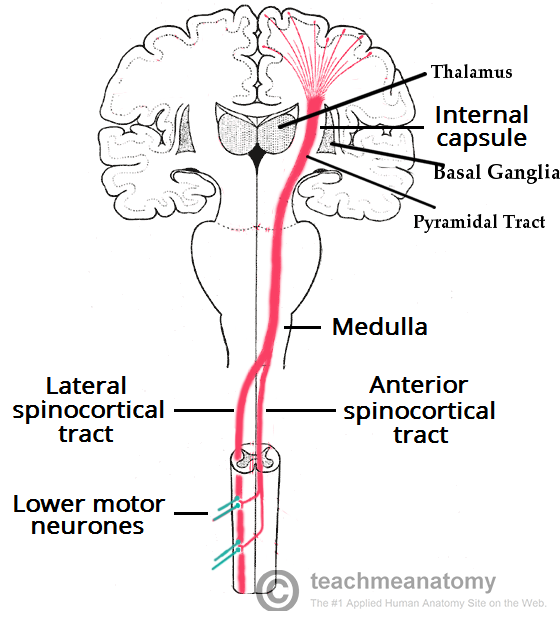Pyramidal Tract
Definition
Pyramidal tract is a collection of axons that travel between the cerebral cortex of the brain and the spinal cord.
Synonym : Corticospinal tract
Structure
Pyramidal tract contains motor axons.
Two separate tracts in the spinal cord:
1. The lateral corticospinal tract
2. The anterior corticospinal tract.
One tract in the brain stem
3. The corticobulbar tract . (carries signals that control motor neurons located in cranial nerve brain nuclei)
The neurons of the pyramidal tracts are called pyramidal neurons
When the pyramidal tract passes the medulla, it forms a dense bundle of nerve fibres that is shaped like a pyramid.
The course and nomenclature
This pathway starts in the precentral gyrus and ends in the spine.
Once the axons leave the pyramidal cells, they enter the white matter just below and form the corona radiata.
The corona radiata dives into the basal ganglia. At this point called the internal capsule.
Sensory information travels up the tract from the thalamus to the cortex
Motor information travels down to the spine.
At the level where the midbrain begins, the axons are called the cerebral peduncles
At the level of pons, many of the axons from cortex (the "corticopontine" fibers) get off and synapse with pontine nuclei.
The remaining corticospinal axons continue down.
In the medulla, the fibers are called the pyramids because they look like pyramids
At the very caudal-most end of the medulla, the fibers in the pyramids cross. (decussation of the pyramidal tract)
The cerebrum controls the opposite side of the body
After decussation the corticospinal fibers are called the lateral corticospinal tract.
In the spinal cord they synapse either on interneurons (most common) or directly on the a-motor neurons. They preferentially innervate the limbs and distal muscles.
Applied anatomy
The internal capsule is very vulnerable to strokes (ischaemia) leading to hemiplegia.



